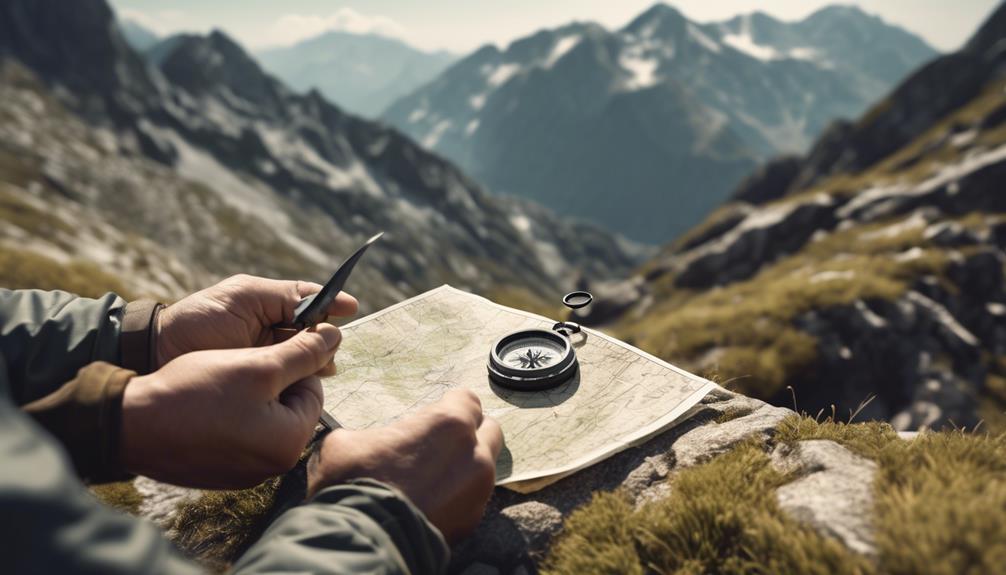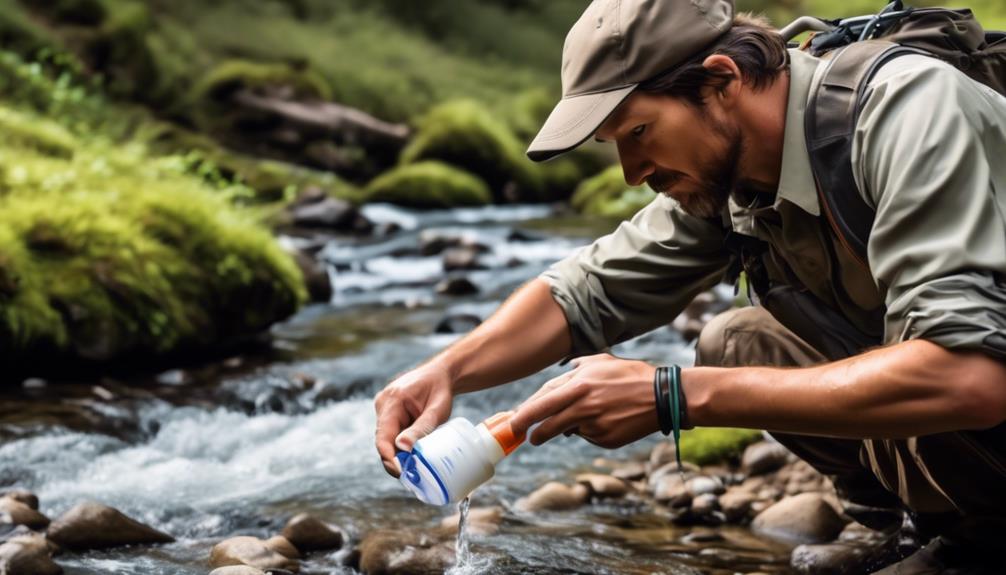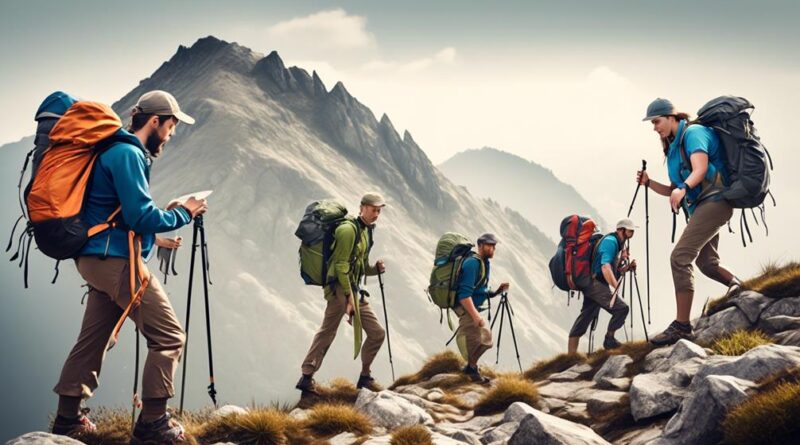12 Essential Tips for Mountain Survival Training Holidays
Imagine finding yourself in a remote mountainous area, facing unexpected challenges such as sudden weather changes and limited resources. You'd want to be equipped with the essential skills to navigate and survive in such conditions.
This is where mountain survival training holidays come into play. Whether you're a seasoned hiker or an outdoor enthusiast looking to enhance your skills, these 12 essential tips will not only prepare you for the unexpected but also ensure that you make the most of your mountain adventure.
So, are you ready to take your outdoor skills to the next level?
Altitude Acclimatization
To acclimate to higher altitudes, gradually increasing your elevation over several days can significantly reduce the risk of altitude sickness. When ascending to higher altitudes, the air becomes thinner, resulting in lower oxygen levels. This can lead to altitude sickness, with symptoms such as headache, nausea, and dizziness. To mitigate these effects, it's crucial to allow your body time to adjust to the reduced oxygen levels.
During the first few days at higher altitudes, your body goes through physiological changes to cope with the decreased oxygen. One of the key adaptations is an increase in your breathing rate to bring in more oxygen. Additionally, your body produces more red blood cells to carry oxygen more efficiently. These adjustments take time and can't be rushed. Therefore, it's essential to ascend gradually, allowing your body to acclimatize to the changing conditions.
Rapid ascents can be dangerous, as they significantly increase the risk of altitude sickness. Therefore, it's recommended to increase your elevation by no more than 300-500 meters per day once you reach 2,500 meters above sea level. Taking regular rest days to allow your body to adjust is also crucial.
Proper Gear Selection
Select appropriate gear for your mountain survival training holiday to ensure safety and comfort during your outdoor activities. Proper gear selection is crucial for a successful and enjoyable experience in the mountains. Start by ensuring your gear is well-maintained. Before embarking on your trip, thoroughly inspect all equipment to ensure it's in good working condition. Check for any signs of wear and tear, and perform any necessary repairs or replacements. This includes inspecting your tent, backpack, sleeping bag, and any other essential gear to ensure they're in optimal condition for your mountain adventure.
When it comes to clothing layers, it's essential to pack the right gear to stay warm and dry in changing weather conditions. Layering your clothing allows you to easily regulate body temperature and manage moisture. Start with a moisture-wicking base layer to keep sweat away from your skin. Add insulating layers to retain body heat, and top it off with a waterproof and breathable outer shell to protect against wind and rain. Make sure to pack extra layers in case of unexpected weather changes.
Additionally, don't forget about the importance of proper footwear. Invest in sturdy and waterproof hiking boots that provide ankle support and traction. Keep in mind that your gear should be tailored to the specific conditions and activities of your mountain survival training holiday. By selecting the right gear and maintaining it properly, you'll be well-prepared to face the challenges of the wilderness.
Navigation Skills

Before you head out into the mountains, mastering navigation skills is essential for ensuring your safety and successfully navigating the rugged terrain. Here are some crucial tips to help you improve your navigation skills and enjoy a safe and successful mountain survival training holiday:
- Map Reading and Compass Navigation: Familiarize yourself with reading topographic maps and using a compass to determine your direction. Understanding contour lines, symbols, and scales on a map will help you visualize the terrain, while compass navigation will guide you in the right direction, especially when visibility is poor.
- GPS Usage and Landmark Identification: While GPS devices can provide precise coordinates, understanding how to use them effectively is crucial. Learn how to mark waypoints, track your route, and interpret GPS data. Additionally, being able to identify prominent landmarks such as peaks, rivers, and distinct rock formations will aid in orienting yourself within the landscape.
- Practice in Varied Conditions: Test your navigation skills in different weather conditions and terrains. Practice navigating through dense forests, open fields, and steep slopes. Learning to adapt your skills to various environments will enhance your confidence and ability to navigate effectively.
- Seek Professional Guidance: Consider enrolling in a navigation course or joining guided expeditions to learn from experienced instructors. Their knowledge and expertise can provide valuable insights and hands-on training, ensuring you develop a strong foundation in navigation skills.
Emergency Shelter Building
Consider building an emergency shelter using natural materials found in the surrounding environment to provide protection from the elements during your mountain survival training holiday. When constructing a shelter in the wilderness, prioritize finding a location that's shielded from wind and close to a water source, but not in a potential flood zone. Look for fallen branches, leaves, and other natural debris to create a simple lean-to or A-frame shelter. Use the keyword 'shelter construction' to guide your actions. Ensure that the shelter is sturdy and can withstand any potential harsh weather conditions.
In the event of an emergency during your mountain survival training holiday, it's crucial to have a basic understanding of wilderness first aid. This knowledge can be invaluable when dealing with potential injuries in a remote area. Always carry a first aid kit and learn how to apply basic first aid techniques for treating wounds, fractures, or exposure-related conditions. Wilderness first aid skills can make a significant difference in ensuring the safety and well-being of yourself and others in a challenging environment.
Water Procurement

Ensuring adequate hydration is paramount for your survival in the mountains, where procuring safe drinking water can be a challenging yet essential task. In desert environments, water sources may be scarce, making it even more crucial to prioritize water procurement. Here are some tips to help you stay hydrated and safe:
- Purifying Techniques: Learn and practice various water purification methods such as boiling, using water purification tablets, or investing in a portable water filter. These techniques can make even the most questionable water sources safe to drink, reducing the risk of waterborne illnesses.
- Hydration Importance: Understand the signs of dehydration and the critical importance of staying hydrated, especially in high-altitude environments. Carry a reusable water bottle and make a habit of drinking water regularly, even if you don't feel thirsty.
- Water Sources: Familiarize yourself with potential water sources in the mountains, such as streams, rivers, and natural springs. However, always purify water from these sources before drinking, as they may contain harmful pathogens.
- Protecting Water Supply: Take measures to protect your water supply from contamination. Store water in clean, sealable containers, and keep them away from potential pollutants.
Fire Starting Techniques
As you navigate through the mountains, mastering fire starting techniques is essential for your safety and survival, serving as a crucial skill to complement your water procurement knowledge.
When it comes to fire starting techniques, there are several methods you can employ. Friction fire, one of the most primitive methods, involves rubbing two pieces of wood together to create friction and generate heat, eventually leading to a fire. While this technique requires practice and patience, it can be a life-saving skill in the wilderness.
Additionally, flint and steel techniques are effective for creating sparks to ignite dry tinder, making it a reliable method for starting a fire in various weather conditions.
In addition to learning different fire starting techniques, it's important to be mindful of fire safety precautions. Always clear the area around the fire site to prevent the spread of flames, and never leave a fire unattended.
Furthermore, understanding fire building strategies is vital for maintaining a sustainable and long-lasting fire. Building a proper fire lay, such as a teepee or log cabin structure, can help the fire burn efficiently and provide the warmth and light you need.
Food Foraging

When exploring the mountains, knowing how to identify and gather edible plants and wild foods is a valuable skill for sustaining yourself in the wilderness. Food foraging can provide you with essential nutrients and energy during a survival situation.
Here are some essential tips to help you with food foraging in the mountains:
- Edible plants: Learn to identify common edible plants such as wild berries, dandelions, and wild onions. These plants can provide important vitamins and minerals that are crucial for maintaining your health in the wilderness.
- Wild mushrooms: Be cautious when foraging for wild mushrooms as many can be toxic. It's important to educate yourself about the varieties of wild mushrooms that are safe to eat. Look for experienced guides to help you identify edible mushrooms and avoid any potential risks.
- Survival cooking: Once you have gathered edible plants and wild foods, it's essential to know how to cook them properly. Simple survival cooking techniques such as boiling, roasting, or steaming can make these foods more palatable and easier to digest.
- Improvisation techniques: In a survival situation, you may not have access to traditional cooking tools. Learn improvisation techniques such as using hot rocks for cooking or creating makeshift cooking utensils from natural materials.
Survival Mindset
Developing a resilient mindset is essential for surviving in the mountains and overcoming the challenges of the wilderness. When embarking on mountain survival training holidays, resilience building and mental toughness are crucial aspects to focus on. The unpredictable nature of the mountains demands a strong mindset that can adapt to various situations and endure hardships.
Resilience building involves preparing yourself mentally for the difficulties you may encounter in the mountains. It's about cultivating the ability to stay focused and positive, even when faced with adversity. During your training, you'll be pushed beyond your comfort zone, and it's essential to embrace these challenges with a mindset geared towards growth and learning.
Mental toughness is developed through pushing past limits, staying determined in the face of discomfort, and maintaining a strong resolve when things get tough. It's about finding the strength to keep going even when the going gets tough.
To build resilience and mental toughness, it's important to practice techniques such as visualization, positive self-talk, and goal setting. These strategies can help you stay focused, maintain a positive outlook, and push through challenging situations. Additionally, learning to embrace discomfort and uncertainty can help you develop the mental fortitude needed to thrive in the mountains.
Frequently Asked Questions
What Are the Potential Dangers of Wildlife Encounters During Mountain Survival Training Holidays?
When encountering wildlife during mountain survival training holidays, it's crucial to prioritize safety measures. Always take precautions by staying alert, making noise to avoid startling animals, and knowing the emergency response protocol in case of an encounter.
Are There Any Specific First Aid Skills or Training That Participants Should Have Before Embarking on a Mountain Survival Training Holiday?
Before embarking on a mountain survival training holiday, you should have first aid preparation and wilderness first aid training. These skills are crucial for survival in the wilderness. Knowing how to respond to emergencies can make a big difference.
How Do Participants Cope With Extreme Weather Conditions Such as Snowstorms or Heavy Rain During the Training?
When you're facing extreme weather conditions like snowstorms or heavy rain during mountain survival training, coping strategies are crucial. Build emergency shelters using available materials, and prioritize staying dry and warm to protect yourself from the elements.
What Are the Best Practices for Waste Disposal and Leave-No-Trace Principles in Mountain Survival Training Environments?
When in the mountains for survival training, it's crucial to follow leave-no-trace principles. Proper waste management and campsite etiquette are essential to minimize environmental impact. Always pack out what you pack in.
How Can Participants Effectively Signal for Help in the Event of an Emergency During Their Mountain Survival Training Holiday?
In the event of an emergency during your mountain survival training holiday, effective communication is key. Carry survival gear and signaling devices such as whistles, signal mirrors, or brightly colored items to alert others for help.
Conclusion
In conclusion, mountain survival training holidays are a great way to build essential skills and confidence in the wilderness. By focusing on altitude acclimatization, gear selection, navigation, shelter building, water procurement, fire starting, food foraging, and maintaining a survival mindset, you'll be better prepared for any outdoor adventure.
So, whether you're a beginner or an experienced hiker, these tips will help you make the most of your mountain survival training experience.
Stay safe and enjoy the journey!
